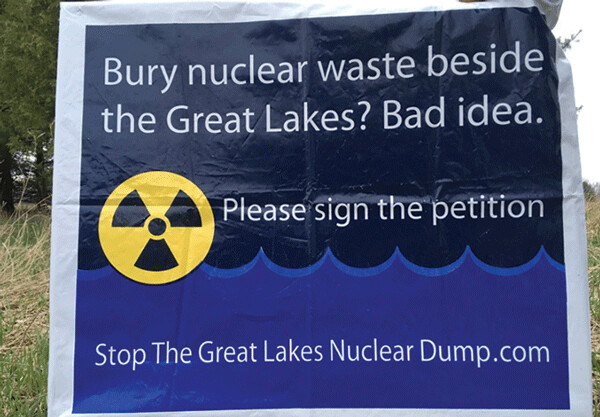News & Articles
Browse all content by date.

Nuclear power enthusiasts like to say, “Nuclear waste disposal is a political, not a scientific problem.” Scientists refute this slogan every day.
A case in point is the Canadian Environment Minister’s second “do over” order issued to Ontario Power Generation regarding the company’s waste dump idea. The 15-page order, issued April 5, rejected the company’s sophomoric answers to a previous “not good enough” finding by Canada’s Minister of Environment and Climate Change, Catherine McKenna. (http://www.ceaa-acee.gc.ca/050/document-eng.cfm?document=118537)
Ontario Power Gen. (OPG) wants to bury 7 million cubic feet of radioactive waste in a deep hole less than a mile from Lake Huron, on its own property on the Bruce Peninsula, northwest of Toronto. It’s there that OPG runs the world’s biggest rad’ waste production complex — the Bruce Nuclear Station — eight old power reactors in varying states of repair and disrepair.
OPG proposes digging 2,231 feet down into part of its 2,300-acre compound near the lake, and burying all sorts of radioactive material (everything except waste fuel rods), including a “significant amount” of carbon-14, a cancer agent with a deadly radioactive “life” of 57,300 years. After two years of public hearings on the question of placing long-lasting poisons next to a major drinking water source (see my testimony at https://www.youtube.com/watch?v=TlAtdC0SmuI), the federal Joint Review Panel recommended approval of the project to Minister McKenna in 2015.
McKenna was expected to make a decision by March 1, 2016, but instead demanded more work from OPG. On Feb. 18, 2016, McKenna ordered the company to produce details about alternative dump sites. OPG submitted its guesswork nine months later, on Dec. 28, 2016. But McKenna’s April 5 reply is a scathing denunciation of OPG’s failed obfuscations and blatant non-answers. Beverly Fernandez, founder of Stop the Great Lakes Nuclear Dump, said to columnist Jim Bloch, writing in Clinton, Michigan’s The Voice, “OPG has been given a failing grade on its most recent report regarding burying its radioactive nuclear waste less than a mile from the Great Lakes. OPG has now been issued a strong set of new challenges to answer.”
For example, the company claimed that, “All underground facilities (office, tunnel, emplacement room) will be constructed in accordance with the seismic requirements of the latest edition of the National Building Code at the time of the construction.” In fact, as the Minister’s April 5 rejection of OPG’s snow-job noted, “There are no specific seismic requirements in the National Building Code for underground facilities.”
A public servant doing her job
Asking about other potential sites for deep geological disposal, Minister McKenna required OPG to make “specific reference to actual locations.” Instead, OPG tried to get away with citing two enormous geological regions that it said might be potentially suitable. Plotted by Matthew Cole of the Toronto Star, OPG’s “actual locations” covered an area of 726,052-square-kilometres — about 75% of the Province of Ontario. This preposterous attempt at scamming the government didn’t fool McKenna, a public servant who is actually doing her job.
In an embarrassing show of environmental racism, OPG’s Dec. 2016 report on alternate sites failed to analyze or even acknowledge the land use Treaty Rights of Indigenous or First Nation peoples. Minister McKenna’s rebuke rightly demands that the company provide “a description of the land and resource uses for the alternative locations that highlight the unique characteristics of these locations from the perspective of Indigenous peoples.
McKenna’s critique of OPG’s study amounts to “strike two” against the company, and her refutation brought howls of affirmation from community leaders and watchdogs around the Great Lakes. So far, 187 cities, townships, counties, states and provinces in the Great Lakes Basin have passed resolutions opposing the dump — including Duluth, Minn. Jim Bloch, the columnist, asked, “How many swings will the Canadian government give Ontario Power Generation before the firm strikes out in its request to build a nuclear waste dump on the shores of Lake Huron?” The answer may be ‘no more.’ As befits questions of persistent cancer agents and how to containerize and keep them out of drinking water for thousands of years, McKenna’s April 5 rebuke lists 23 complex and technically dumbfounding dilemmas that could doom the Lake Huron dump plan. As Professor Erika Simpson at the University of Western Ontario reviewed McKenna’s critique and wrote April 7, “It will take OPG perhaps a decade to come up with all the information that is now required … given all the overwhelming problems identified.”
Beverly Fernandez summed up the opposition as well as anyone. “Given the overwhelming opposition to this plan and the potential for massive consequences to the Great Lakes, no responsible government would approve a plan that endangers the drinking water of 40 million people, and a $6 trillion Great Lakes economy.”
| Tweet |

